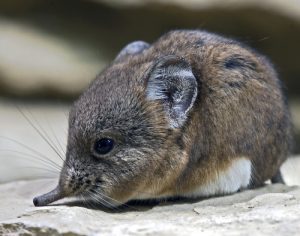Shrews Can Be Indoor Pests, but Rarely
By Chris Williams on February 9, 2012.
Q. My cat brought me a small animal that looks kind of like a mouse and is about the size of a mouse, but it has a long pointed snout. Do you know what this is?
A. I think you might be talking about a shrew. Shrews are small animals that are common outdoors where they nest in rotting leaves, stumps, or abandoned burrows. They are not rodents, however, but are classified as “insectivores” because their primary food is insects, worms, snails, slugs, and other small arthropods like centipedes. They occasionally feed on small birds, mice, or snakes. And in the winter when animal food is scarce, they may revert to eating roots, seeds, and nuts.
To the untrained eye, a shrew does look somewhat like a mouse, but you can tell the difference by their elongated snout, small, beady eyes, and ears that are almost hidden in the fur. Their front feet are rodent-like, unlike the enlarged digging claws of moles. While mice have four toes, shrews have five. Shrews also have a foul odor to ward off predators. Their droppings are a corkscrew shape.
 I assume your cat caught the shrew outside since shrews are a rare indoor pest. Unlike mice, they do not easily move indoors but they will to escape adverse conditions outside—for example, too cold or too wet. They may move indoors looking for food. They have been reported to enter buildings most often in the fall to feed on insects which have also moved indoors because of the cold. Or, the cat may bring in a captured shrew as a “present.” We found two shrews inside our home in the space of a week which was at first very puzzling. I finally determined that the shrews were entering the garage under our not-too-tight garage door gasket. The cat was capturing the shrews in the garage and then bringing them into the house through the kitty door so he could play with them later!
I assume your cat caught the shrew outside since shrews are a rare indoor pest. Unlike mice, they do not easily move indoors but they will to escape adverse conditions outside—for example, too cold or too wet. They may move indoors looking for food. They have been reported to enter buildings most often in the fall to feed on insects which have also moved indoors because of the cold. Or, the cat may bring in a captured shrew as a “present.” We found two shrews inside our home in the space of a week which was at first very puzzling. I finally determined that the shrews were entering the garage under our not-too-tight garage door gasket. The cat was capturing the shrews in the garage and then bringing them into the house through the kitty door so he could play with them later!
Shrews are active day and night, year round. They do not hibernate. Shrews can be nasty and aggressive and they have sharp teeth. They have been reported to attack pets, and to attack birds or chipmunks at feeders. If you expect to handle a shrew, wear heavy gloves.
Keeping thick vegetation away from your home’s perimeter will help deter shrews. The main control to keep shrews from getting indoors is to pest-proof around the outside of your home, sealing openings that shrews can use to get inside (we can do that for you). Shrews that get inside can be captured with traps. Place snap traps along shrew runways (travel routes) as you would for mice and bait the traps with a mixture of peanut butter and rolled oats, maybe with a touch of bacon grease. There are no repellents, poisons, or fumigants registered for use against shrews.